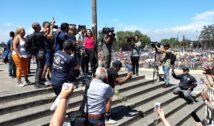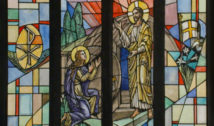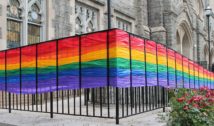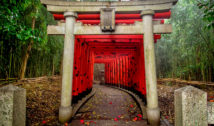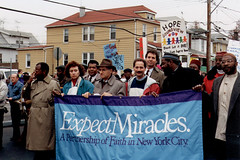
America’s Growing Interfaith Infrastructure
- By WRN Editorial Staff --
- 16 Sep 2019 --
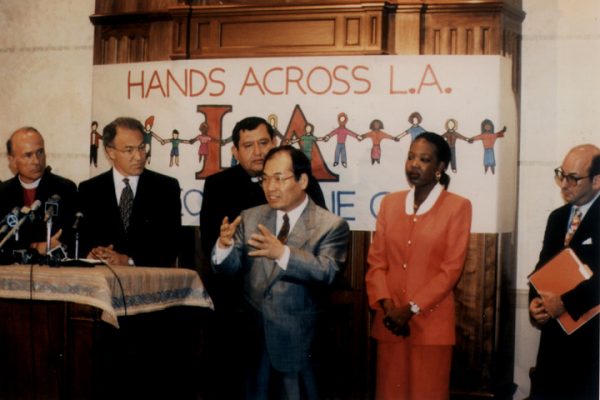 In Columbia, South Carolina, Interfaith Partners regularly brings together for discussion Christians and Jews, Hindus and Muslims, Buddhists and Bahá’ís. Members visit one another’s places of worship, gather over meals, sponsor a program on inter-religious awareness for schools, and undertake an annual conference on interfaith dialogue. Interfaith Partners of South Carolina was launched in part by the faculty and students of the University of South Carolina. As one Christian participant put it: “The amazing thing is, when you learn about others, it inevitably causes you to learn about yourself. You become a different person in the process of meeting someone who has been previously unknown to you.” A Muslim participant explained: “We all live on one globe, and we’re working together here in Columbia, so there’s a need to get acquainted with one another, whether we accept each others’ differences or not, and find common ground. Then we can advance society.”
In Columbia, South Carolina, Interfaith Partners regularly brings together for discussion Christians and Jews, Hindus and Muslims, Buddhists and Bahá’ís. Members visit one another’s places of worship, gather over meals, sponsor a program on inter-religious awareness for schools, and undertake an annual conference on interfaith dialogue. Interfaith Partners of South Carolina was launched in part by the faculty and students of the University of South Carolina. As one Christian participant put it: “The amazing thing is, when you learn about others, it inevitably causes you to learn about yourself. You become a different person in the process of meeting someone who has been previously unknown to you.” A Muslim participant explained: “We all live on one globe, and we’re working together here in Columbia, so there’s a need to get acquainted with one another, whether we accept each others’ differences or not, and find common ground. Then we can advance society.”
Interfaith Partners of South Carolina is one of hundreds of initiatives that seek to foster engagement across lines of religious difference, efforts that are often collectively called the “interfaith movement.”[/tweetit] A movement is not an organization: it has no single center, but is constituted by a common energy and commitment to improve relations between people of different religions. As the soil of society changes, a multitude of new interfaith groups have sprung up. Some interfaith groups focus on learning and understanding through dialogue; others address common social concerns; still others revolve around campus environments, or public spaces such as hospitals or prisons. Amid these different approaches, the movement represents a new cultural consensus: that better relations can be intentionally cultivated to shape a better society.
Interfaith councils were a significant new development in American society in the late twentieth century, and they continue to diversify in the present day. Councils of churches, churches and synagogues, and clergy associations have had to face the question of whether to extend the roundtable to include representatives of other religious traditions. This happened in Wichita, for example, when Inter-Faith Ministries, founded by Christian ministers in the 1880s, came to include Jewish, Bahá’í, Muslim, Hindu, and Buddhist members. Syracuse’s Interfaith Works of Central New York began in 1975 when the Metropolitan Church Board decided the community needed a council to represent all faith traditions, not just Christians. Today, Interfaith Works supports refugee resettlement, a food bank, projects serving people experiencing homeless, companionship programs for the elderly, and an annual city-wide rubber duck race that serves as a fundraiser for anti-racism efforts.
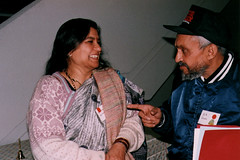 Interfaith groups often are born from the practical necessity of addressing serious community issues. A Partnership of Faith in New York City began in 1990 when clergy from several religious traditions met to make a united response to rising levels of urban violence. Today, their “trialogues” bring Jews, Christians, and Muslims together to “unite their voices on behalf of justice, peace, and healing in New York City.” In Salt Lake City, Utah Interfaith Power & Light—a chapter of a broader national organization, Interfaith Power and Light—brings together different religious and philosophical communities around the issue of climate change and environmental justice, offering energy audits for local worship communities and green congregational partnership programs. In Atlanta, graffiti, violence, and zoning laws against Jewish and Hindu temple construction projects defined the direction of the Gwinnett Interfaith Coalition, which proceeded to help establish a county-wide human rights task force. Today, the Coalition has become a chapter of the Georgia Interfaith Alliance, a member organization of the Washington D.C.-based advocacy organization, The Interfaith Alliance.
Interfaith groups often are born from the practical necessity of addressing serious community issues. A Partnership of Faith in New York City began in 1990 when clergy from several religious traditions met to make a united response to rising levels of urban violence. Today, their “trialogues” bring Jews, Christians, and Muslims together to “unite their voices on behalf of justice, peace, and healing in New York City.” In Salt Lake City, Utah Interfaith Power & Light—a chapter of a broader national organization, Interfaith Power and Light—brings together different religious and philosophical communities around the issue of climate change and environmental justice, offering energy audits for local worship communities and green congregational partnership programs. In Atlanta, graffiti, violence, and zoning laws against Jewish and Hindu temple construction projects defined the direction of the Gwinnett Interfaith Coalition, which proceeded to help establish a county-wide human rights task force. Today, the Coalition has become a chapter of the Georgia Interfaith Alliance, a member organization of the Washington D.C.-based advocacy organization, The Interfaith Alliance.
One of the oldest interfaith groups is the Interreligious Council of Southern California in Los Angeles, founded in 1969 as a Catholic, Jewish, and Protestant organization. Today the Council includes Bahá’í, Buddhist, Greek Orthodox, Muslim, Sikh, and Hindu representatives. In the wake of the L.A. riots in 1992, the Interreligious Council organized a massive “Hands Across L.A.” event in which citizens of every faith came out to demonstrate their commitment to working together by forming a human chain many miles long across the heart of Los Angeles. Over the years, the Council has supported the appointment of a Buddhist chaplain in the State Senate and has also backed the Sikhs in their petition to the L.A. Police Department to be allowed to serve as policemen while wearing the required beard and turban. When the Hsi Lai Buddhist temple in Hacienda Heights was stalled in five years of zoning battles, the Council came to the aid of the Chinese Buddhist community; they demonstrated similar support for the Vedanta Society, the Muslim community, and the Thai Buddhist community engaged in similar zoning battles. As founder and Roman Catholic Monsignor Royale M. Vadakin insists, the Council’s strength lies in its web of relationships. “You cannot institutionalize trust and friendship,” he said.
Colleges and universities have emerged as sites of innovative approaches to engagement and to chaplaincy. Many American public and private colleges and universities are changing chaplaincy, religious life, and/or student affairs structures to reflect the growing religious diversity on campus. Liberal arts colleges established a century or more ago and linked to Christian denominations have, in many cases, led the way. The Wellesley College Multi-Faith Chaplaincy is one of the first to wholly alter its conception of college religious life. No longer is Christianity at the center of the wheel with subsidiary chaplaincies to minorities, but the whole conception has become multireligious, as have all official Wellesley College events.
Getting to know one another and developing relationships of trust is also a process that takes time. The Interfaith Conference of Metropolitan Washington began in 1978 with Protestants, Catholics, Jews, and Muslims; over time, the collaboration has gradually grown to include Mormon, Sikh, and Hindu participants. To join the Interfaith Conference, each faith community has “observer” status for one year. As Executive Director Clark Lobenstein puts it, “The long process allows us to get to know each other and to establish the trust that will allow us to work together.” But spending time building bridges of trust is important: when the water rises, so to speak, it is often too late to build makeshift bridges. After a Jewish settler fired upon Muslims at prayer in Hebron, Gaza, the Interfaith Conference of Metropolitan Washington was able to arrange an interfaith service at the Muslim Community Center at which the chairman of Washington D.C.’s Board of Rabbis spoke. Lobenstein explained, “In the charged atmosphere following a crisis like Hebron there is no time to build trust. Both the rabbi who spoke and the Muslim Community Center told me they simply had to trust the fact that they trusted the Interfaith Conference.”
Similarly, after the 2010 Park51 controversy—in which a proposed Islamic community center and prayer space in lower Manhattan became a target for anti-Muslim animus and received national attention—and related violence against Muslims across the country, the Minnesota Council of Churches partnered with 27 religious and nonprofit groups to sponsor a massive interfaith service in Minneapolis, “Minnesotans Standing Together.” Over a thousand Minnesotans attended the service which was also broadcasted on local news channels. In these instances in Washington D.C. and Minneapolis, communities were able to build upon existing relationships to respond to the urgency created by current events.
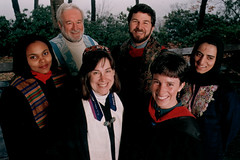 Within the common work of building relationships, each organization also has a distinctive style and practice. In Central Ohio, the Interfaith Association organizes house meetings in which five to seven people of different religions meet in one another’s homes to talk about their faith. The Grand Rapids Interfaith Dialogue Association in Michigan also emphasizes this small group dialogue experience and has expanded its efforts to sponsor an annual educational conference. The DuPage Interfaith Resource Network addresses the many educational and community-building needs of the western suburbs of Chicago. One Jewish participant described the suburbs as “the interfaith frontier,” where the next big developments in America’s interreligious relations will take place. The Interfaith Community Institute in Atlanta, Georgia offers intensive trainings and workshops for leaders of religious communities. In Cleveland, Building Bridges connects local religious and social justice communities through community murals and arts projects. The Tri-Faith Initiative in Omaha, Nebraska is in the process of planning and building a campus that will include a Christian church, a Jewish synagogue, and Muslim mosque, as well as a center for interfaith and community events. A case study about the initiative, “An Invitation to a Tri-Faith Neighborhood,” was completed by the Pluralism Project in 2011 and is available online.
Within the common work of building relationships, each organization also has a distinctive style and practice. In Central Ohio, the Interfaith Association organizes house meetings in which five to seven people of different religions meet in one another’s homes to talk about their faith. The Grand Rapids Interfaith Dialogue Association in Michigan also emphasizes this small group dialogue experience and has expanded its efforts to sponsor an annual educational conference. The DuPage Interfaith Resource Network addresses the many educational and community-building needs of the western suburbs of Chicago. One Jewish participant described the suburbs as “the interfaith frontier,” where the next big developments in America’s interreligious relations will take place. The Interfaith Community Institute in Atlanta, Georgia offers intensive trainings and workshops for leaders of religious communities. In Cleveland, Building Bridges connects local religious and social justice communities through community murals and arts projects. The Tri-Faith Initiative in Omaha, Nebraska is in the process of planning and building a campus that will include a Christian church, a Jewish synagogue, and Muslim mosque, as well as a center for interfaith and community events. A case study about the initiative, “An Invitation to a Tri-Faith Neighborhood,” was completed by the Pluralism Project in 2011 and is available online.
The case study of the Tri-Faith Initiative was completed as part of a Pluralism Project pilot study, America’s Interfaith Infrastructure: An Emerging Landscape, funded by the Arthur Vining Davis Foundations. In addition to reaching hundreds of interfaith organizations by survey, the study evaluated promising practices, profiled leaders, and highlighted case studies from interfaith initiatives in twenty U.S. cities. According to survey responses from interfaith organizers across the nation, “relationship-building,” “education,” and “dialogue” are the three most common purposes they felt spoke to the central mission of their organization. Time and again, the friendships forged from these efforts seem to create vital channels for communication that prove invaluable in times of controversy. In Jacksonville, Florida, for example, a local interfaith group, OneJax, found itself relying on its strong network when a divisive and inflammatory public debate erupted over the appointment of Dr. Parvez Ahmed, a local Muslim resident and former member of CAIR, to a position on Jacksonville’s Human Rights Commission. Together, OneJax and its allies played a critical role by organizing efforts behind the scenes, publicly sharing their voice in meetings and through formal statements, and as individuals by sending letters to city council and the media.
Every public institution in America today faces the challenges of pluralism, and developing an interfaith infrastructure for increasingly multi-religious cities and suburbs is increasingly becoming a priority on the American agenda. Due to the complex reality of America’s religious life, hundreds of new expressions of interfaith activity are all part of a growing, nationwide experiment in broadening pluralism. Together, they indicate a growing and vibrant interfaith infrastructure.
Reprinted with the permission of The Pluralism Project Staff from The Pluralism Project: Harvard University.












